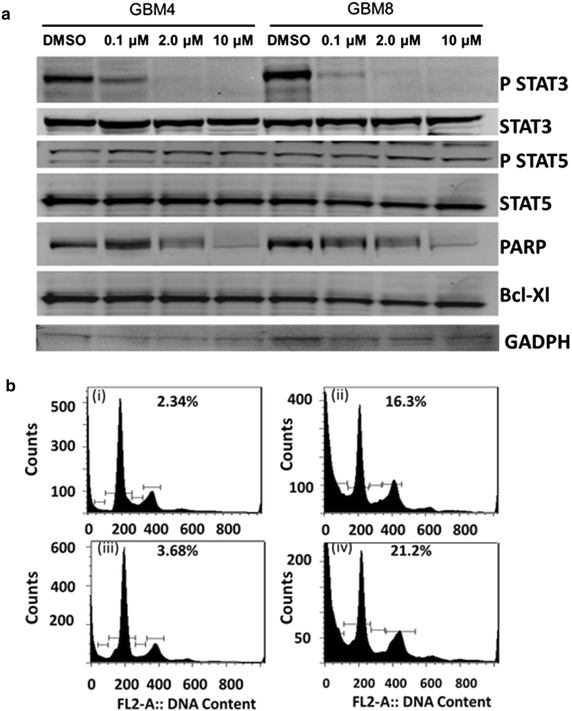Effect of the JAK2/STAT3 inhibitor SAR317461 on human glioblastoma tumorspheres
- PMID: 26283544
- PMCID: PMC4539675
- DOI: 10.1186/s12967-015-0627-5
Effect of the JAK2/STAT3 inhibitor SAR317461 on human glioblastoma tumorspheres
Abstract
Background: The STAT3 transcription factor is a major intracellular signaling protein and is frequently dysregulated in the most common and lethal brain malignancy in adults, glioblastoma multiforme (GBM). Activation of STAT3 in GBM correlates with malignancy and poor prognosis. The phosphorylating signal transducer JAK2 activates STAT3 in response to cytokines and growth factors. Currently there are no JAK-STAT pathway inhibitors in clinical trials for GBM, so we sought to examine the anti-GBM activity of SAR317461 (Sanofi-Aventis), a newer generation, highly potent JAK2 inhibitor that exhibits low toxicity and good pharmacokinetics. SAR317461 was initially approved for patient testing in the treatment of primary myelofibrosis (PMF), and has shown activity in preclinical models of melanoma and pulmonary cancer, but has not been tested in GBM.
Methods: We hypothesized that a potent small molecule JAK2 inhibitor could overcome the heterogeneous nature of GBM, and suppress a range of patient derived GBM tumorsphere lines and immortalized GBM cell lines. We treated with SAR317461 to determine IC50 values, and using Western blot analysis we asked whether the response was linked to STAT3 expression. Western blot analysis, FACS, and cell viability studies were used to identify the mechanism of SAR317461 induced cell death.
Results: We report for the first time that the JAK2 inhibitor SAR317461 clearly inhibited STAT3 phosphorylation and had substantial activity against cells (IC50 1-10 µM) from 6 of 7 different patient GSC derived GBM tumorsphere lines and three immortalized GBM lines. One patient GSC derived line did not constitutively express STAT3 and was more resistant to SAR317461 (IC50 ≈25 µM). In terms of mechanism we found cleaved PARP and clear apoptosis following SAR317461. SAR317461 also induced autophagy and the addition of an autophagy inhibitor markedly enhanced cell killing by SAR317461.
Conclusions: We conclude that SAR317461 potently inhibits STAT3 phosphorylation and that it has significant activity against those GBM cells which express activated STAT3. Further studies are warranted in terms of the potential of SAR317461 as single and combined therapy for selectively treating human patients afflicted with GBMs expressing activation of the JAK2-STAT3 signaling axis.
Figures





References
-
- Mrugala MM. Advances and challenges in the treatment of glioblastoma: a clinician’s perspective. Discov Med. 2013;15(83):221–230. - PubMed
-
- Grossman SA, Ye X, Piantadosi S, Desideri S, Nabors LB, Rosenfeld M, et al. Survival of patients with newly diagnosed glioblastoma treated with radiation and temozolomide in research studies in the United States. Clin Cancer Res. 2010;16(8):2443–2449. doi: 10.1158/1078-0432.CCR-09-3106. - DOI - PMC - PubMed
MeSH terms
Substances
LinkOut - more resources
Full Text Sources
Other Literature Sources
Medical
Molecular Biology Databases
Research Materials
Miscellaneous

